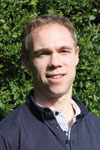Three weeks after the Fukushima accident, a clearer picture is beginning to emerge of possible long-term environmental consequences. The US Department of Energy (DOE) aerial survey of radiation doses was a crucial development. A clear trace reaching out 30–40 kilometres northwest of the plant marked a zone of dose rate above 125 microsieverts per hour, a level at which immediate evacuation is often advised. Already, external doses are rapidly declining as a result of the decay of short-lived isotopes. But, as with the 1986 Chernobyl accident, it is caesium-137, with a half-life of 30.2 years, that will determine the long-term impact on the contaminated region and its residents.
The extent of caesium-137 contamination at Fukushima is not yet clear, but available data indicate very high levels in some areas. The 30 March press release from the International Atomic Energy Agency (IAEA) reports caesium-137 deposition ranging from 0.02 to 3.7 megabecquerels per square metre (MBq m–2) at sites 25–58 kilometres from the Fukushima plant. The higher values are consistent with Japanese soil data from Iitate village, 40 kilometres northwest of the plant. Perhaps surprisingly, there is still no clear information on caesium-137 contamination within 20 kilometres of the plant (the distance of the evacuation zone), although the DOE map implies that this could be of the order of megabecquerels per square metre if the isotopic composition of deposits near the plant is similar to that in the area farther to the northwest.
“The social and psychological responses to radiation are of paramount importance.”
The implications of these data are far-reaching. If large areas are contaminated with 0.5 MBq m–2 or more, evacuation could be for the long term. After Chernobyl, long-term evacuation usually occurred in areas with radioactivity above 0.55 MBq m–2, although some believe that this limit could have been safely set much higher. Contamination of the food chain will depend on soil type: soils rich in clay bind radiocaesium strongly: bioavailability in organic upland and forest soils is generally significantly higher than in mineral soils. On the basis of the Fukushima data seen so far, it seems likely that in some areas, food restrictions could hold for decades (J. T. Smith et al. Nature 405, 141; 2000), particularly for wild foodstuffs such as mushrooms, berries and freshwater fish.
'Liquidators' could be brought in to decontaminate towns and villages in evacuated zones and reclaim farmland, although this approach met with varying success at Chernobyl. The UK Health Protection Agency's Recovery Handbook for Radiation Incidents details a range of measures for residential areas, including removal of top soil and resurfacing of roads. On farms, approaches to remediation include applying potassium fertilizers to crops to compete with radiocaesium uptake, and giving 'Prussian blue' boluses to grazing animals to reduce radiocaesium absorption.
Remediation has some drawbacks: huge economic cost, for example, and potentially massive quantities of contaminated waste. Consumers may refuse products grown in contaminated areas even when they meet regulations. Chernobyl has taught us that the social and psychological responses to radiation are of great, perhaps paramount, importance.
'Headline' estimates of Chernobyl's public-health impact are dramatic: one 2006 estimate led by the International Agency for Research on Cancer foresaw 16,000 cases of thyroid cancer and 25,000 other cancers resulting from the radiation, among "several hundred million cancer cases from other causes". But risks to the individual are low. As early as 1991, an IAEA study found psychological effects to be "wholly disproportionate to the biological significance of the radiation". This study placed a high priority on providing accurate information about radiation health risks to affected populations. But 15 years later, the UN Chernobyl Forum Report still concluded that Chernobyl's impact on mental health is "the largest public-health problem caused by the accident to date". Misperceptions, and inefficient compensation, have led to widespread fatalism and feelings of victimization among locals. Resulting rises in alcohol consumption and smoking may well have done more damage than radiation exposure (see Nature 471, 562–565; 2011). The failure to solve social and psychological problems relates not only to a lack of effort (at Chernobyl, vastly more has been spent on physical remediation than on public engagement), but also to the intractability of the problem.
ADVERTISEMENT
The long-term response to Fukushima will have to be pragmatic. The Japanese authorities may have to rewrite the rule-book, as they have begun to do in allowing doses of 250 mSv for radiation workers. After an accident, it may be appropriate to set exposure limits for members of the public higher than the typical 1 mSv per year maximum. A limit of 5–10 mSv per year (perhaps with voluntary resettlement at doses above 1 mSv per year) may be appropriate, bearing in mind that millions of people in areas of high natural radioactivity worldwide are exposed to more than 10 mSv per year, and that occupational exposures (for example, to long-haul air crews) can be around 5 mSv per year.
A turning point in my understanding of Chernobyl's impacts came while studying lakes in Belarus during the mid-1990s. In an evacuated area, lake fish contained tens of thousands of becquerels per kilogram. A couple in their early seventies lived near the lake, eating the fish and growing vegetables. They were living off contaminated land, but leading the life they had chosen to lead. This wouldn't by any means be the right choice for everybody, but I am convinced they had made the right decision for them: they were Chernobyl survivors, not victims.
Jim Smith is co-editor and lead author of Chernobyl: Catastrophe and Consequences (Springer, 2005). He is currently reader in environmental physics at the University of Portsmouth, UK. e-mail: jim.smith@port.ac.uk

